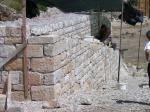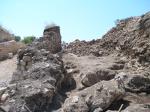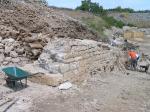Summary (English)
In the village of Ivoševci, on the site of the Roman military camp Burnum, the Drniš City Museum, in cooperation with the University of Zadar, Department of Archeology, continued the systematic archaeological and conservation works on the amphitheatre. This building is located in the western part of the Roman military camp and excavation on this position began in the fall of 2003 and continues until today. In 2006, excavation was carried out at the southern entrance of the amphitheatre, and it was followed by the conservation, structural repairs and partial reconstruction of the southern entrance, which were also carried out. Since at the southern entrance, fragments of Vespasian’s inscription were found at different levels, while in the rubble that backfilled the passage, structural parts of the vault were recorded at different heights, it can be concluded that the collapse of the vault and the filling of the passage was occurring gradually, probably caused by the dilapidation of the building and disturbed statics.
In 2006, excavation was continued on the layer of rubble that leans on the walls of the southern entrance. To prepare the walls for conservation and structural repairs, trenches over 25 m long and about 3 m wide were opened on both sides along the walls. The number of Roman coins found was large, and belong to the first half of the 1st century. Also found were parts of military equipment (iron arrowheads, spears, javelins, parts of helmets, various fittings from leather and textile parts of equipment, etc.), many fibulae, and needles for various purposes, medical instruments, and bone artefacts. In particular, the large number of fragments of various ceramic vessels (terra sigillata, terra nigra, coarse domestic pottery, lamps, etc.) and glass fragments should be emphasized. The finds in the deposits above the bedrock are of military provenance and the relatively narrow chronological range in which they were used, together with the established stratigraphy, shows that it was a backfill created before the construction of the amphitheatre and that it probably originates from a nearby military facility from the time of Emperor Claudius. It is likely that during the preparation of the terrain for the construction of the amphitheatre, the wider area was levelled, so in the backfills of the depressions in bedrock both chronologically and typologically similar archaeological material can be expected (Joško Zaninović 2007, Hrvatski arheološki godišnjak 3/2006, 364–366).
- Joško Zaninović
Director
- Joško Zaninović
Team
Research Body
- Gradski muzej Drniš
- Odjel za arheologiju Sveučilišta u Zadru
Funding Body
- Ministarstvo kulture Republike Hrvatske
- Nacionalni park Krka






![Download [PDF]](/excavation/skins/fasti/images/results/download_sml.png)

